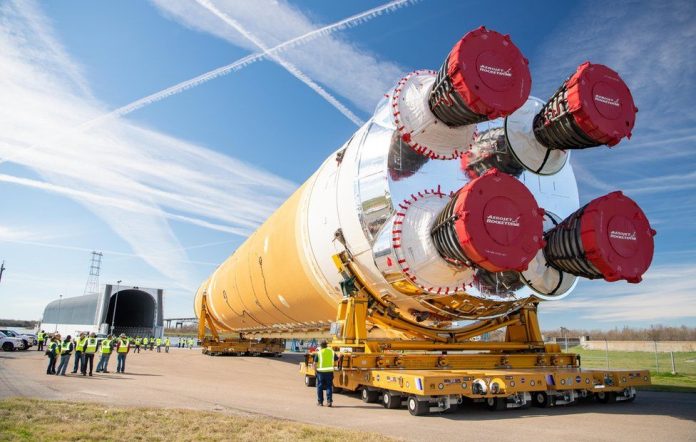NASA has unveiled the supersized Space Launch System (SLS) which will help launch astronauts in the Artemis I mission to return man to the moon – as well as the first woman – in 2024 before colonising Mars.
The 212-foot-long (65 meters) SLS core stage rolled out of NASA’s Michoud Assembly Facility in New Orleans Wednesday (Jan. 8) and was loaded onto a barge, agency officials announced.
That barge will soon depart for NASA’s Stennis Space Center in Mississippi, where the booster will endure a crucial, months-long “green run” test designed to demonstrate its fitness to send astronauts to the moon, Mars and other deep-space destinations.
A jazz band from a local high school escorted the booster out to the road Wednesday, said John Shannon, SLS vice president and program manager at Boeing, the prime contractor for the rocket’s core stage.
“It was just a fantastic way to celebrate this historic milestone — sending the most complicated vehicle that’s ever been built at Michoud, by far, out on its way to the test facility,” Shannon said during a call with reporters on Wednesday afternoon.
The journey to Stennis will take about 9 hours, he added. The voyage is not yet underway, however; the travel date depends on the weather.
The SLS is key to NASA’s human spaceflight plans. The rocket’s first iteration, known as the Block 1, will stand 322 feet (98 m) tall and generate 8.8 million lbs. of maximum thrust at liftoff — 15% more than the agency’s iconic Saturn V rocket, which launched the Apollo missions to the surface of the moon. The SLS core stage’s four RS-25 engines will provide about 2 million lbs. of that thrust; the rest will come from two strap-on solid rocket boosters.
The future Block 2 SLS will be even brawnier, producing nearly 12 million lbs. of maximum thrust at liftoff.
The core that just left Michoud will fly in the Block 1 configuration, on the very first flight of the SLS. That mission, known as Artemis 1, will launch NASA’s Orion capsule on an uncrewed journey around the moon. Artemis 1 is currently scheduled to launch no earlier than November of this year.
But the SLS core has to pass the green run before Artemis 1 can get off the ground. That test series will put the core stage through its paces, checking out its many complicated and interconnected subsystems and ultimately lighting up the four RS-25 engines for a full 8 minutes — the amount of time they’ll fire on an actual mission to the moon. (The “green” in “green run,” by the way, refers to the previously untested nature of the hardware on the stand.)
If everything goes well with the green run and Mother Nature cooperates, the test campaign could wrap up by July or August, Shannon said. But weather issues, and the need to refurbish the core after various subtests, may well push completion into October, he added.
After the green run is done, the core stage will take another, much longer barge trip — an eight- to 12-day trek around Florida’s west coast and back up the state’s east side to NASA’s Kennedy Space Center, the Artemis 1 launch site.















